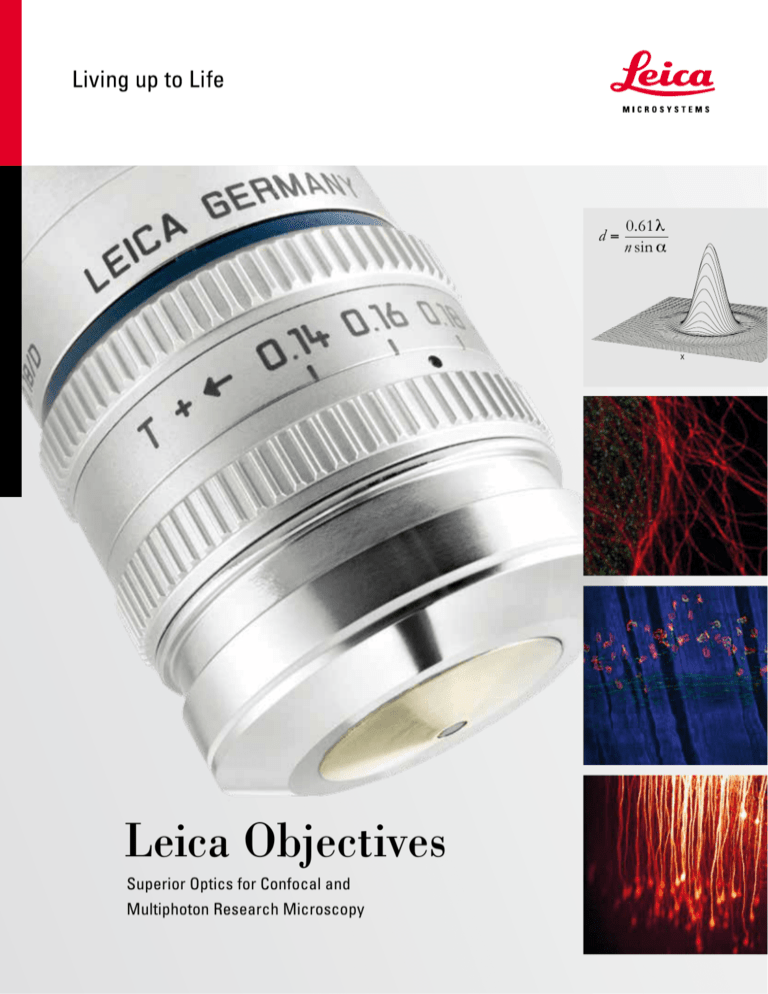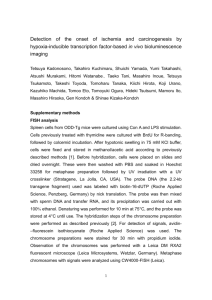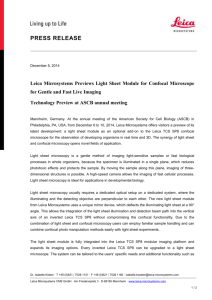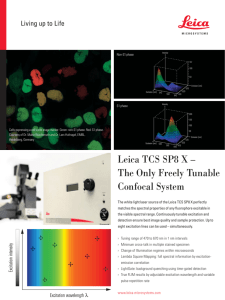Leica Objectives - Leica Microsystems
advertisement

d= 0.61λ n sin α X Leica Objectives Superior Optics for Confocal and Multiphoton Research Microscopy Leica Microsystems: Optics for Your Discoveries We have designed and produced superior optics for a wide variety of applications in research, industry, and medicine for more than 160 years. Today, the innovation power of our optics ­designers and the experience and expertise of our precision optical engineers come together to provide m ­ icroscopes with the best possible optics for spectral imaging. A sophisticated state-of-the-art production p­ rocess yields objectives that deliver superlaWorking “with the user, for the user” (Ernst Leitz I, 1843–1920) tive image quality. We also help you to choose the best describes our drive to innovate optics with optical c­ haracteristics that are tailored to and the success of Leica your requirements. Microsystems for over 160 years. Leica TCS 4D – First four-detector confocal for multi-dye applications First use of AOTF for laser modulation in a confocal First spectral detector in confocal microscopy Leica TCS SP2 – First confocal with excitation from UV to IR Confocal Innovations 1992 1993 1994 1995 1996 1997 1998 1999 Objective Innovations HC optics system ensures superlative optical performance First dedicated objectives for confocal scanning (CS) with improved axial color specification 2000 2001 3 AOBS – First reprogrammable beam splitter 2002 2003 Leica TCS SP5 X – First white light laser confocal with tunable VIS excitation Leica TCS SP5 – Broadband confocal with the first switchable tandem scanner 2004 λ blue objectives optimized for 405 nm excitation 2005 2006 2007 2008 2009 Leica TCS SP8 – New confocal platform, modular system Leica TCS SP5 MP with OPO, excitation up to 1300 nm 2010 2011 First motCORR objectives with motorized correction collar IRAPO objectives with color correction up to 1300 nm Leica TCS SP8 STED 3X – Fast and direct super-resolution 2012 2013 HC PL APO STED WHITE with superior broadband color correction Leica HC PL APO CS2 for full VIS application spectrum 2014 First motCORR for objectives with 75 mm parfocal distance Objective Class 4 Magnification (5) 1x /1.25x 1.6x /2 x 2.5x /3.2 x Magnification/ 4x / 5x Numerical Aperture 6.3x /8x Immersion 10x /12.5x Correction Collar 16x /20x Confocal Scanning 25x /32 x 4 0x / 50x 63x /80x 100x Correction Collar Immersion Water Oil Glycerol 5 Choose the Best Objective for Your Needs The name of an objective describes its specifications and target applications. This guide gives you an overview of the technical terms and abbreviations. PL/PLAN – Excellent field planarity (1) Objective with a flattened field of view for the representation of thin specimens, crucial for confocal microscopy of thin objects. APO/IRAPO/FLUOTAR – Appropriate color correction is required for colocalization in multicolor specimens. Wavelength range of correction (2) In addition, high transmission of an objective for the excitation and emission wavelengths is necessary for maximum image brightness. L – Long free working distance Long distance between the objective front lens and the focus plane offers good access to the specimen for complex experimental setups and enables acquisition of large z-stacks in thick tissues. Objective Magnification (3) Factor by which the objective enlarges the object in the intermediate image plane. Numerical Aperture The numerical aperture determines the lateral and axial resolution as well as the image brightness. Oil/W/Glyc/IMM – Type of The ideal choice of immersion directly depends on the mounting medium, because immersion medium (4) focusing deep into the specimen is only possible with homogenous immersion, i.e. mounting medium and immersion having the same refractive index. CORR/motCORR – Manual or Corrects for variations in coverglass thickness, temperature, and refractive index motorized correction collar of the specimen. Motorized correction collar is remote-controlled for easy, precise adjustment. CS/CS2 – Highest specifications Apochromatic objectives optimized for confocal scanning deliver the best color for confocal scanning correction. Leica objectives comply with (1) ISO19012-1, (2) ISO19012-2, (3) ISO8039, (4) ISO8036, (5) ISO8578. 6 High Numerical Aperture for Best Resolution Numerical aperture and wavelength directly influence the resolving power of a microscope. Resolution improves with higher numerical apertures and lower wavelengths. NUMERICAL APERTURE POINT SPREAD FUNCTION The numerical aperture (NA) of an objective is described by The point spread function (PSF) describes how an imaging the sine of the half-angle α of the maximum cone of light that system represents a point object in three dimensions. The PSF can enter or exit the lens multiplied by the refractive index n of a fluorescence microscope is dependent on the numerical of the immersion medium. aperture of the system and the wavelength. NA = n sin α In confocal microscopy, the pinhole diameter also has to be This also deterimines the maximum NA technically possible considered. If the pinhole diameter is set to 1 Airy Unit (AU) for different immersion media. only the signal included in the Airy disk, i.e. the central Maximum angle maximum, is detected. αmax ≈ 72° Dry immersion (nair = 1.0) NA max ≈ 0.95 Oil (noil = 1.518) ›› High NA for best resolution in thin and well-defined specimen NA max ≈ 1.44 ›› Low NA for larger depth of field for thick samples with lower requirements in resolution 1 1 Calculated point spread functions for HCX PL APO Objective non- immersion Immersion none nair = 1.00 αair αoil immersion) and HC PL oil noil = 1.518 APO 40x/1.30 Oil CS2. nglass = 1.518 Coverglass Specimen 40x/0.85 CORR CS (no oil-immersion A larger NA ­results in a 2 1 Limiting ray 2 Total internal reflection Y X intensities. The numerical aperture of an objective depends on the half-angle of the aperture. For non-immersion objectives the maximum angle of light that can still be collected by the objective is smaller than for immersion objectives. Y PL APO 40x/1.30 OIL indicated by a smaller spot size and in higher PL APO 40x/0.85 CORR X higher resolving power x x 2.0 1.0 z y 1.0 0.5 0 0 –0.5 Rayleigh Limit –1.0 FWHM FWHM –1.0 lateral axial µm –2.0 µm LATERAL RESOLUTION AXIAL RESOLUTION AND OPTICAL SECTION THICKNESS For a rough estimation of the resolving power of a fluores- The volume of the PSF is not only restricted horizontally in cence microscope in x and y, applying the Rayleigh criterion the focus plane but also vertically along the optical axis of is usually sufficient. Here, the maximum of the Airy disk of the microscope (z). The axial resolution of a microscope system one point overlaps with the first minimum of the Airy disk is worse than its lateral resolution, approximately by a factor of the second point (left, shown in blue). of two. A more practical approach is to use the full width at half The major advantage of the confocal microscope is that only maximum (FWHM) of the PSF. This is also true for a confocal light originating from the focal plane is detected. Out-of-focus microscope with the pinhole equal to or larger than 1 Airy light is blocked by the detection pinhole. This drastically improves Unit (AU) (left, shown in green). the effective axial resolution of a confocal microscope. For pinholes significantly smaller than 1 AU, the FWHM ›› The axial resolution depends on the square of the NA decreases further. However, chosing a smaller pinhole of the objective. diameter often reduces the signal-to-noise ratio, and any ›› For low NA objectives, the PSF becomes very elongated. lateral resolution gain is lost in the noise. ›› For high NA objectives, the axial resolution is approximately twice the lateral resolution. ›› The lateral resolution linearly depends on the NA of the objective. Background: Estimating resolution and FWHM Diffraction limited minimal axial FWHM Lateral resolution in xy according from fluorescent specimens. The pinhole to the Rayleigh criterion: Lateral FWHM of PSF for a fluorescent point object, with PH ≥ 1 AU d= 0.61λ NA FWHMlateral = 0.51λ NA diameter is assumed to be zero. Optical section thickness dz in dependence of the dz (PH) ~ = pinhole diameter (PH) as it is implemented in Leica Application Suite Advanced Fluorescence (LAS AF) software. dz ~ = 0.61λexc n – n2 – NA2 λexc· n 2 n· 2· PH + NA2 NA 2 8 Highly Corrected Optics for Better Images Precise optical design and high manufacturing standards ensure that the imaging errors inherent in every optical system are reduced to a minimum. SPHERICAL ABERRATIONS FIELD CURVATURE Spherical aberration is the dominant Field curvature is a monochromatic imaging error that needs to be corrected aberration that causes the optimal focus in high numerical aperture optics. position to vary with the image point An objective with spherical aberrations position. It increases quadratically with has no well-defined focus. the distance between the image point and the center of field. As a result, the Spherical Aberration Real image plane (curved) Objective Blurring Ideal image plane (flat) Field Curvature Spherical aberrations blur the image image is increasingly blurred toward the across the whole field of view. The edge of the field. blurring cannot be compensated by refocusing. It already occurs in the center Objectives with high magnifications of field and remains constant over the possess greater positive refractive whole field of view. power and therefore generally greater field curvature. Especially for confocal ›› Leica objectives are spherically corrected for at least the same microscopy of thin specimens, field curvature should be corrected. wavelength range as the color correction. ›› PL – or PLAN – objectives are corrected for field curvature and show a flat field of view as well as minimized astigmatism ›› Acquire sharp images over the whole field of view Background: Monochromatic Aberrations ›› Astigmatism: cross- or line-like deformation of image points Monochromatic aberrations already ›› Coma: comet-like distortion of a point occur when using a single wavelength. ›› Field curvature: curved image plane ›› Defocus: image is out of focus ›› Image distortion: barrel or pincushion ›› Spherical: no well-defined focus point AXIAL COLOR LATERAL COLOR Axial color causes the optimal focus Lateral chromatic aberration causes the position to vary with the wavelength. magnification to vary with the This aberration occurs in the center of wavelength. It increases linearly with field and remains constant over the the distance between the image point whole field of view. and the center of field. In polychromatic applications this Image points near the edge of the field aberration causes a loss of contrast, show a distinctive colored smearing for colored fringes and a best focus which the human eye is very sensitive. that is not color-neutral. In quantitative applications, this makes Axial Color overlay of images with different Correction of axial color is critical fluorophores difficult. in confocal microscopy, especially for time-sensitive multi-wavelength ›› The quality and wavelength range fluorescence applications when of axial and lateral color correction refocusing would take too long. is indicated by the objective class. ›› Chromatic correction matching the Axial color aberrations are caused by experimental setup guarantees optimal the natural dispersion of optical glasses. colocalization in xy and z. By chosing different glass types, this aberration can be eliminated. Background: Chromatic Aberrations ›› Axial color: color-shift in z Chromatic aberrations appear in addition ›› Lateral color: magnification dependent to monochromatic aberrations when on color, color-shift in xy depends on using multiple wavelengths. position in image Lateral Color 10 It’s All About Color Preparing your specimen for microscopy is only the first step to a stunning image. Choosing the best objective for your purpose should be done with as much care. Besides magnification and numerical aperture, the appropriate color correction is crucial. Apochromatic Color Correction Focal plane [µm] 2.0 Apochromats allow the image resolution to reach the diffraction 1.5 limit over a wide range of wavelengths. For fluorescence imaging, 1.0 all excitation and detection wavelengths must be included to ensure that image resolution is as high as physically possible. 0.5 0.0 For optimal colocalization, superior color correction of apochro­-0.5 380 430 480 530 580 630 680 730 780 830 880 930 980 1030 1080 1130 1180 mats guarantees a variation of the focus plane less or equal to half of the depth of field within a specified wavelength range. Wavelength [nm] Calculated axial chromatic aberration for HC PL APO 100x/1.40 OIL CS2. The position of the focus plane at different wavelengths shows almost no deviation over a wide Objective Transmission range of wavelengths. Production tolerances can lead to small variations. The grey The transmission of an objective is determined by the glass types lines indicate the depth of of field. it is manufactured from and the amount of losses due to Transmission [%] 100 reflections at the optical interfaces. The transmission is wavelength-dependent. As a general rule, transmission of short 80 wavelengths is limited by glass properties, while transmission 60 of long wavelengths is limited by the a­ nti-reflective coatings. 40 Leica Microsystems designs and manufactures complex 20 anti-reflective coatings to increase transmission to the 0 300 400 500 600 700 800 900 Wavelength [nm] 1000 maximum. The Leica HC PL IRAPO objectives for example deliver superior broadband transmission that is higher than Transmission curve for HC PL APO 40x/1.30 OIL. Production tolerances can lead to 85% from 470 to 1200 nm. small variations. FURA DAPI Photoactivation standard confocal imaging PL APO CS2 multicolor MP MP CARS OPO PL APO CS2 refocus – one λ Transmission > 85% 470–1200 nm, PL IRAPO color correction range dependent on objective 700 nm PL APO UVIS CS2 PL APO UVIS CS2 650 nm refocus – one λ Wavelength ranges of color correction for objective classes ­recommended for confocal imaging. 350 nm 405 nm 480 nm 800 nm 1100 nm 1300 nm 1 2 3 PL APO CS2 PL IRAPO PL FLUOTAR Highest Specifications for IR Color Correction for Multicolor Objectives for Routine Confocal Scanning Multiphoton Imaging and CARS Fluorescence Imaging The apochromatic Leica CS2 objectives Leica PL IRAPO objectives are highly The semi-apochromatic, universal are optimized for confocal scanning specified for improved multiphoton PL FLUOTAR objectives feature good (CS). Their color correction is outstanding imaging. chromatic correction for visible over the whole field of view for precise wavelengths. This makes them well colocalization of different fluorophores. The IR apochromats are color corrected suited for standard fluorescence In particular the lateral color has been from at least 700 nm up to 1300 nm microscopy. further improved over the previous to yield perfect overlap for multicolor PL APO CS series. multiphoton imaging and CARS In confocal microscopy, these are an (Coherent Anti-Stokes Raman economic choice for overview images ­Scattering). and imaging within a limited wavelength The design of the CS2 objectives goes hand in hand with the innovative UV range. optics of the Leica TCS SP8, to give Transmission is > 85 % from 470–1200 nm, the most stable UV color correction. maximizing the number of photons available for multiphoton excitation Specialized objectives developed for and emission detection. This results 355 nm excitation or STED super-resolution in brighter images from deeper tissue microscopy are part of the CS2 objective class. sections and reduced photodamage. 12 Matching Objective Immersion and Specimen In addition to the objective itself, the refractive indices of all optical elements between the specimen and the front lens of the objective have a major influence on the image quality. Ideally, they should match the refractive index the objective has been designed for. This has to be kept in mind when choosing an objective and immersion medium for a certain application. OIL: STANDARD FOR FIXED SAMPLES GLYCEROL: THE OPTIMUM FOR MOUNTED WATER: PERFECT MATCH FOR LIVE CELL SPECIMENS IMAGING AND THICK SPECIMENS Immersion oil is designed to match the Today, most fixed samples are mounted Water immersion objectives are optimal refractive index of standard crown glass in Mowiol, Vectashield or similar mixtures for observing living cells in aqueous media. (ne =1.518). Oil immersion objectives are based on glycerol. These media have The refractive indices of the immersion ideally suited for samples that are mounted refractive indices close to that of a medium and the specimen are a closer in a medium that matches the refractive 80/20 glycerol/water mixture (ne =1.45). match than immersion oil, for example. classically fixed specimens embedded in Leica glycerol objectives are an excellent Water immersion objectives with high resin, Canada balm or glycerol-gelatine. choice for samples mounted in such numerical apertures are very sensitive media. They offer a correction collar to to refractive index variations. Therefore, Oil immersion objectives can also be adjust the optics to varying refractive each is equipped with a correction collar. used when imaging close to the cover­- indices caused by changes of the com­- It moves the central lens group to restore glass, i.e. less than a few micrometers position of the mounting medium, or optimal image resolution and brightness. deep. Further away from the coverglass, from variations in coverglass thickness the image brightness and resolution will or temperature. index of glass. This is the case for Leica Microsystems offers water immersion deteriorate quickly if the refractive lenses with motorized correction collars indices are mismatched. for accurate, remote-controlled adjustment of the correction collar (see page 17). Medium 1 with refractive index n e,1 α1 Background: Refractive Index For the generation of an image it is Incident angle The refractive index (RI) describes the important that light changes direction speed of light in a medium relative to when traveling from one medium to Refractive angle the speed of light in a vacuum. The another if they have different RIs. with n e,1 < n e,2 Medium 2 with refractive index n e,2 α2 RI is dependent on temperature and wavelength. For the latter see the For an overview of RIs of common media Background Box on the Abbe number. please refer to the back page. Background: Abbe Number IMM: GENERALISTS AND SPECIALISTS For multicolor imaging, the dispersion of the immersion medium should not Immersion objectives labelled with IMM The specialists – special purpose be neglected. It is a measure of the are either for use with multiple immersion immersion objectives: variation of the refractive index with media like water, glycerol and oil or ›› HC FLUOTAR L 25x/1.0 IMM motCORR wavelength and is described by the for specialized immersion media with VISIR for CLARITY-treated specimen refractive indices varying from the (ne =1.457) ­standard immersion media. ›› HCX APO L 20x/0.95 IMM for BABB (ne =1.563) Abbe number. The Abbe number of a medium should match the objective design, other­- The generalists – Leica multi-immersion wise chromatic aberrations will occur. objectives: Let us assume that two different ›› HC PL APO 10x/0.40 IMM CS immersion oils with Abbe numbers ›› HC PL APO 20x/0.75 IMM CS2 that lie at opposite ends of what is are for use with water, glycerol, and oil. specified by the ISO norm are used with the HC PL APO 100x/1.40 OIL CS2 objective. Then, the resulting axial color between 405 nm and FWHM in reflection [µm] 2 not optimized not optimized 544 nm is around 300 nm. This is significant when considering the axial resolution of a confocal microscope. Leica CS and CS2 oil optimized (0°) 1 immersion objectives are designed for Leica immersion oil type F. 0 -50 -25 0 correction collar position [°] 25 4 0:00 h 0:01 h 0:02 h 0:05 h 0:30 h 1:00 h 1:30 h 2:00 h 2:30 h 17:00 h 5 15 Designed for Live Cell Imaging The refractive index of living cells and their surrounding culture medium is close to the refractive index of water. Therefore, the best choice for live cell imaging is a water immersion objective. With the unique motorized correction collar, water immersion micro dispenser, and adaptive focus control you can easily acquire high-resolution images during long time-lapse experiments. MOTORIZED CORRECTION COLLAR FOR AUTOMATIC SUPPLY OF WATER KEEP YOUR FOCUS WITH BEST OPTICAL PERFORMANCE IMMERSION DURING EXPERIMENTS ADAPTIVE FOCUS CONTROL The optical performance of high NA Water immersion has one drawback: The Leica DMI6000 with Adaptive Focus water immersion objectives is highly water quickly evaporates. Especially at Control (AFC) for live cell applications sensitive to refractive index mismatches. 37 °C and during screening or Mark & Find ensures that the specimen is actively Precise adjustment of the correction experiments the immersion film can be kept in focus even under demanding collar ensures that optimal resolution, disrupted. environmental conditions. The Water Immersion Micro Dispenser The fully automated AFC is the ultimate overcomes these problems by adding tool for long-term time-lapse recordings The motorized correction collar of the immersion automatically during a in combination with multi-positioning, Leica motCORR™ objectives simplifies running experiment. z-stacking and multifluorescence signal intensity and penetration depth is restored. the workflow by quickly adjusting the objective lenses to varying coverglass thickness, changes in temperature, and specimen inhomogeneities. experiments. ›› Software-controlled water pump, no interaction required ›› AFC is compatible with a large selection of objectives ›› Steady water supply for long-term experiments at 37 °C ›› Cap design prevents disruption of 2 water film during stage movement 2 3 1 4 3 5 1 1 Focus position 2 Culture medium 1Motor 3 Cover glass 2 Water cap 4 Immersion medium 3 Lens group to correct for changes 5Objective in refractive index or coverglass thickness 6 6 Detection sensor with light spot 16 A Clear View Deep in Tissues Imaging depth in biological tissues is limited by light scattering caused by refractive index mismatches within the specimen. There are two approaches to overcome this limitation. For multiphoton excitation, longer wavelengths up to 1300 nm are used to reduce scattering. Additionally, novel optical clearing methods use organic solvents to reduce scattering and maximize imaging depth in intact tissue. Clearing and multiphoton imaging can be combined. COLOR CORRECTION FOR MOTORIZED CORRECTION COLLAR MAXIMUM ACCESS AND ISOLATION MULTIPHOTON IMAGING FOR DEEP TISSUE IMAGING FOR ELECTROPHYSIOLOGY Multiphoton excitation requires wave- We have designed objectives ideally High numerical aperture dipping objec­- length about twice as long as for standard suited for deep tissue imaging, combining tives with inert ceramic fronts and large fluorescence imaging, i.e. in a range excellent color correction with our of 680-1300 nm. Emission of the fluoro- motorized correction collar. Adjustment of electrophysiology experiments. Leica phores remains in the visible range the correction collar to the refractive index Microsystems offers a complete range of (450-650 nm). Therefore, both the PL of the specimen allows imaging of deeper dipping lenses and high resolution IRAPO and the FLUOTAR VISIR objectives in tissues with increased brightness and show excellent transmission in the access angles are optimal for sensitive objectives to match your needs. better contrast. visible and infrared. The Leica HC FLUOTAR L 25x/0.95 The Leica motCORR™ is easily W VISIR objective provides maximum FLUOTAR VISIR objectives can be remote-controlled by the control panel clearance around the specimen with an used for confocal imaging as well as and by LAS AF (Leica Application Suite access angle of 41° and a free working ­multiphoton imaging with a broadband Advanced Fluorescence) microscope distance of 2.5 mm. It can be used with color correction. The IRAPO objectives software. This ensures that the confocal microscopes. A version for use are designed for multiphoton imaging, specimen remains undisturbed during with coverglass is available, too. with excellent color correction up to movement of the correction collar. 1300 nm for perfect overlap in multicolor multiphoton imaging and CARS (Coherent Anti-Stokes Raman Scattering). 6 SPECIALIZED OBJECTIVES FOR 100 CLEARED TISSUE SAMPLES The Leica objective HC FLUOTAR L 25x/1.00 IMM (ne=1.457) motCORR VISIR has been designed for the latest tissue clearing techniques in laser scanning microscopy. The result: maximum imaging depth and highest resolution. Transmission [%] 80 60 40 20 HC FLUOTAR L 25x/1.00 IMM motCORR VISIR The objective matches the refractive index of CLARITY-treated specimen. It is equipped with a motorized correction 0 400 500 600 700 800 900 1000 1100 12001300 Wavelength [nm] collar to adjust for remaining refractive index variations. Background: Long Free Working Distance Objectives (L) Free working distance is a decisive measure for many applications. With a free working distance of 6 mm, For example it is important in the following cases: whole organ imaging is possible. The ›› Low magnifications: accessibility of specimen broad range VISIR correction is ideal for ›› Medium magnifications: safety while focusing use with single photon and two-photon ›› Water immersion objectives: focusing deep into the specimen excitation. A large free working distance can only be achieved through special arrangements of the refractive powers inside the objective and so is contrary to other requirements. The free working distances of a number of objectives can be found on pages 22/23. Normalized Autocorrelation 7 0.25 [nM] 182 0.20 137 48 0.15 3 0.10 cytoplasm (data) cytoplasm (fit) nucleus (data) nucleus (fit) 0.05 0.00 0.001 0.01 0.1 1 10 100 Lag Time [ms] 8 Confocal 9 5 μm STED 19 High-end Optics for Demanding Applications For research involving highly specialized techniques or challenging specimens, ­specifically optimized objectives are often needed. Leica Microsystems offers a wide choice of application-specific objectives. THE BEST SPHERICAL AND CHROMATIC STED WHITE – ENJOY THE FULL UVIS: A SHIFT TO THE BLUE FOR CORRECTION FOR FCS SPECTRUM 355 NM EXCITATION Reliable, reproducible fluorescence Super-resolution microscopy places the The Leica HC PL APO 63x/1.20 W CORR correlation spectroscopy (FCS) data highest demands on objective design. UVIS CS2 is an ultra-broadband objective requires a confocal volume that closely Especially multicolor super-resolution dedicated for excitation with 355 nm. resembles the mathematical model used can separate very small structures from in the FCS analysis. Leica PL APO optics each other, provided that the optics are It provides excellent color correction feature excellent spherical and color highly color-corrected. from 345-730 nm. This makes it the ideal correction for FCS and FCCS (Fluorescence Cross-Correlation Spectroscopy). As the specimen is usually in an aqueous objective for DNA lesions, photoactivation, The Leica HC PL APO 100x/1.40 OIL uncaging, and physiological experiments STED WHITE objective enables you to using Ca2+-single line and ratio imaging, perform STED microscopy in the full monitoring gene expression or autofluo- environment, water immersion objectives spectrum of visible light in all three are ideal. A high numerical aperture dimensions. Its chromatic correction ensures a small confocal volume for FCS. and transmission are optimally designed However, this requires correction collar for 3D STED. optimization for each specimen to adjust for variations in coverglass thickness and temperature. Our motorized correction collar simplifies this adjustment. rescence. 20 Acknowledgements Title Page: [5] HeLa cells expressing tubulin-EGFP (green) and H2B-mCherry Top: Dual color STED image. Green: histone 3. Red: micro­ (red). Time series acquired at 1 min intervals over 17 hours tubules. Both visualized in HeLa cells with Chromeo 505 and on a Leica TCS SP8. Courtesy of Jutta Bulkescher, ALMF, BD HorizonV500, respectively. Leica Microsystems EMBL, Heidelberg, Germany. Middle: Mouse diaphragm. Green: nerve fiber, Alexa 488. [6] Thy1-YFP adult mouse brain treated with CLARITY. Red: synapses, Rhodamin. Blue: muscle fiber, myosin. DODT Confocal imaging with excitation at 514 nm. Courtesy contrast. Sample: courtesy of Ulrike Mersdorf, Max Planck of Karl Deisseroth and Raju Tomer, Stanford University, Institute for Medical Research, Heidelberg, Germany. Palo Alto, CA, USA. Bottom: Adult Thy1-EYFP H line mouse, in vivo (cranial [7] Concentration mapping of TIF1a-GFP in HeLa cells. ROIs for window). Excitatory pyramidal neurons in Layer 5 partly FCS measurements (red and blue graphs) shown as black express EYFP. Courtesy of Dr. Masahiro Fukuda and Prof. crosses. Courtesy of Dr. Matthias Weiss, Dr. Jedrzej Haruo Kasai, Center for Disease Biology and Integrative Szymanski and Nina Malchus, DKFZ, Heidelberg. Medicine, Faculty of Medicine, The University of Tokyo, Tokyo, Japan. [8] Triple immunostaining in HeLa cells. Green: NUP153-Alexa 532. Red: Clathrin-TMR. White: Actin-Alexa 488. HeLa cells, fixed in methanol, 660 nm gated STED. Huygens [1] Rat primary culture labeled with DAPI, NG2-Cy3 and β3-Tubulin-Cy5. Leica Microsystems [2] Zebrafish (Danio rerio), Neurogenin-GFP. H2A. Courtesy deconvolved xy images, Leica Microsystems. [9] Immunostaining in HeLa cells shows increased level of cyclobutane pyrimidine dimers (CPDs) (green) after locally of J. Legradi, Dr. U. Liebel, KIT Karlsruhe Institute of induced DNA lesions by UVA laser (355 nm) (see region Technology, Germany. of interest in red). Nuclei were visualized by DAPI staining [3] Zebrafish embryo: Lateral Line (GFP, red), neurons (DsRed, (blue). Image acquisition, cell irradiation and immunofluo- red), muscles (SHG, grey), nuclei (BFP, blue). Courtesy rescence was performed by Petra Sehnalová and Soňa of Lionel Newton and Darren Gilmour, EMBL, Heidelberg, Legartová from the Institute of Biophysics, Academy of Germany. Sciences of the Czech Republic, Brno. [4] HeLa cells expressing three different fluorescent proteins: GFP-tubulin (green) Ex 476 nm, Em 485-509 nm, YFP-GPIfilipodia (yellow) Ex 514 nm, Em 517-556 nm, mCherry-H2Bnucleus (red) Ex 561 nm, Em 571-671 nm. Three channels, simultaneously recorded. Courtesy of Jutta Bulkescher, ALMF, EMBL, Heidelberg, Germany. LOOKING FOR A SPECIFIC OBJECTIVE? Detailed information for all objectives is available in the objective finder, CONNECT WITH US www.leica-microsystems.com/ products/microscope-objectives including transmission curves and dimensions for each objective. LEARN MORE ABOUT THE LEICA TCS SP8 More information about the Leica TCS SP8 platform, its applications, CONNECT WITH US www.leica-microsystems.com/ sp8 technology, and software are provided on the Leica TCS SP8 product page. HOW CAN WE HELP YOU? No matter if you have a demo request, questions about your existing Leica system or any other topic, contact us via our website. CONNECT WITH US www.leica-microsystems.com/ contact-support 22 Order No Objective Name FWD (mm) Immersion Coverglass Correction Collar Color Correction VIS High Transmission VIS 15506224 HCX PL Fluotar 5x/0.15 13.70 Dry ♦ – ¢ ll 15506505 HCX PL Fluotar 10x/0.30 11.00 Dry ♦ – ¢ ll 15506507 HCX PL Fluotar 10x/0.30 PH1 11.00 Dry ♦ – ¢ ll 15506142 HCX APO L 10x/0.30 W U-V-I 3.60 Water ♦ – l ll 15506285 HCX PL APO 10x/0.40 CS 2.20 Dry 0.17 – ll l 15506293 HCX PL APO 10x/0.40 IMM CS 0.36 IMM ♦ – ll l 15506503 HC PL Fluotar 20x/0.50 1.15 Dry 0.17 – ¢ ll 15506506 HC PL Fluotar 20x/0.50 PH2 1.15 Dry 0.17 – ¢ ll 15506147 HCX APO L 20x/0.50 W U-V-I 3.50 Water ♦ – l ll 15506517 HC PL APO 20x/0.75 CS2 0.62 Dry 0.17 – ll ll 15506343 HC PL APO 20x/0.75 IMM CORR CS2 0.68 IMM ♦ CORR ll ll 15506344 HC PL IRAPO 20x/0.75 W 0.67 Water ♦ – ¢ ll 15507701 HCX APO L 20x/1.00 W 2.00 Water 0 – l ll 15507702 HCX APO L 20x/0.95 IMM 1.95 ne =1.563 0 – l ll 15506374 HC FLUOTAR L 25x/0.95 W VISIR 2.50 Water 0 – ¢ ll 15506375 HC FLUOTAR L 25x/0.95 W 0.17 VISIR 2.40 Water 0.17 – ¢ ll 15507704 HC IRAPO L 25x/1.0 W motCORR 2.60 Water ♦ motCORR – ll 15507703 HC FLUOTAR L 25x/1.0 IMM motCORR VISIR 6.00 ne =1.457 ♦ motCORR ¢ ll 15506295 HCX PL APO 40x/0.85 CORR CS 0.21 Dry 0.11–0.23 w ll ¢ 15506155 HCX APO L 40x/0.80 W U-V-I 3.30 Water 0 – ¢ l 15506357 HC PL APO 40x/1.10 W CORR CS2 0.65 Water 0.14–0.18 CORR ll ll 15506360 HC PL APO 40x/1.10 W motCORR CS2 0.65 Water 0.14–0.18 motCORR ll ll 15506352 HC PL IRAPO 40x/1.10 W CORR 0.65 Water 0.14–0.18 CORR – ll 15506358 HC PL APO 40x/1.30 Oil CS2 0.24 Oil 0.17 – ll ll 15506359 HC PL APO 40x/1.30 Oil PH3 CS2 0.24 Oil 0.17 – ll ll 15506362 HCX APO L 63x/0.90 W U-V-I CS2 2.20 Water 0 – ¢ l 15506346 HC PL APO 63x/1.20 W CORR CS2 0.30 Water 0.14–0.18 CORR ll ll 15506361 HC PL APO 63x/1.20 W motCORR CS2 0.30 Water 0.14–0.18 motCORR ll ll 15506356 HC PL APO 63x/1.20 W CORR CS2 0/D 0.30 Water 0 CORR ll ll 15506355 HC PL APO 63x/1.20 W CORR UVIS CS2 0.22 Water 0.14–0.19 CORR ll ll 15506353 HC PL APO 63x/1.30 Glyc CORR CS2 0.30 Glycerol 0.14–0.19 CORR ll ll 15506350 HC PL APO 63x/1.40 Oil CS2 0.14 Oil 0.17 – ll ll 15506351 HC PL APO 63x/1.40 Oil PH3 CS2 0.14 Oil 0.17 – ll ll 15506372 HC PL APO 100x/1.40 Oil CS2 0.13 Oil 0.17 – ll ll 15506325 HCX PL APO 100x/1.44 Oil CORR CS 0.10 Oil 0.10–0.22 CORR ll ¢ 15506378 HC PL APO 100x/1.40 Oil STED WHITE 0.13 Oil 0.17 – ll* ll ♦ For use with and without coverglass ll Superior performance, highly recommended – Not available l Excellent performance ¢ Good performance * S TED WHITE objective especially designed for use with STED and STED 3X. Axial color shift of objective <100 nm in VIS 23 Color Correction UV / 405 nm on TCS SP8 High Transmission UV Color Correction >800 nm High Transmission IR – ll – ¢ – ll – – – ll – – – ll ¢ l – l – ¢ – ¢ – – – l – – – l – – – l ¢ l Recommended for FCS Electrophysiology Compatible with Adaptive Focus Water Immersion Phase Control Micro Dispenser Contrast yes yes yes yes yes yes yes yes yes l l – ¢ yes ll l ¢ l yes yes – – ll ll – l – l – l – l – l l ll – l l ll yes yes – – ll ll – – l ll – ¢ – – – ¢ ¢ ¢ l l – l l yes yes l l – l l yes yes yes yes yes yes yes – – ll ll l ll – l yes l ll – l l l ¢ ¢ l l – l ll yes yes l l – l ll yes yes l l – l ll l – l yes l l – l yes l l – l yes l l – l yes ll l ¢ l yes – – – – yes ll l ¢ l yes Yes yes yes yes yes yes yes Subject to change without prior notice. www.leica-microsystems.com Useful Equations and Numbers Rayleigh Criterion d= Full Width Half Maximum 0.61λ n sin α FWHMlateral = 0.51λ n sin α STED Resolution λ Δx ~ n sin α Distance of two point sources at which Lateral FWHM of PSF for a fluorescent the maximum of the second PSF overlaps point object, with PH ≥ 1 AU. 1+ I Is with the first minimum of the first PSF. Details see page 7. Mountant Manufacturer RI Immersion Medium RI Fluoromount-GTM Southern Biotech Assoc. Inc. 1.40 Air 1.000 ProLong®/ProLong® Gold Molecular Probes 1.46 after curing Water 1.333 VECTASHIELD ® Vector Laboratories 1.44 1.450 Vector Laboratories 1.46 after hardening Immersion Type G at 23°C (Glycerol/Water) Mowiol® Kuraray Europe GmbH 1.41–1.49 Glycerol 100% 1.474 TDE/Water – 1.33–1.52 Immersion Type F (Oil) 1.518 VECTASHIELD ® Hard+SetTM How sensitive an objective is to varying coverglass thickness depends on the Immersion Medium With or Without Coverglass Coverglass No 1.5 Coverglass No 1.5H (0.16 – 0.19 mm) (0.17 mm ± 0.005 mm) immersion medium and the numerical Air NA <0.30 NA <0.70 NA >0.70 aperture (NA). For objectives designed Water NA <0.60 NA <0.90 NA >0.90 for use with coverglass (0.17 mm), the Immersion Type G NA <0.80 NA <1.10 NA >1.10 Immersion Type F NA <0.90 NA <1.30 NA >1.30 following table can be referenced as a general rule. Order no.: English 1593003012 ∙ 09/2014/STO ∙ Copyright © by Leica Microsystems 2014, Location, Country, Year. Subject to modifications. LEICA and the Leica Logo are registered trademarks of Leica Microsystems IR GmbH.







